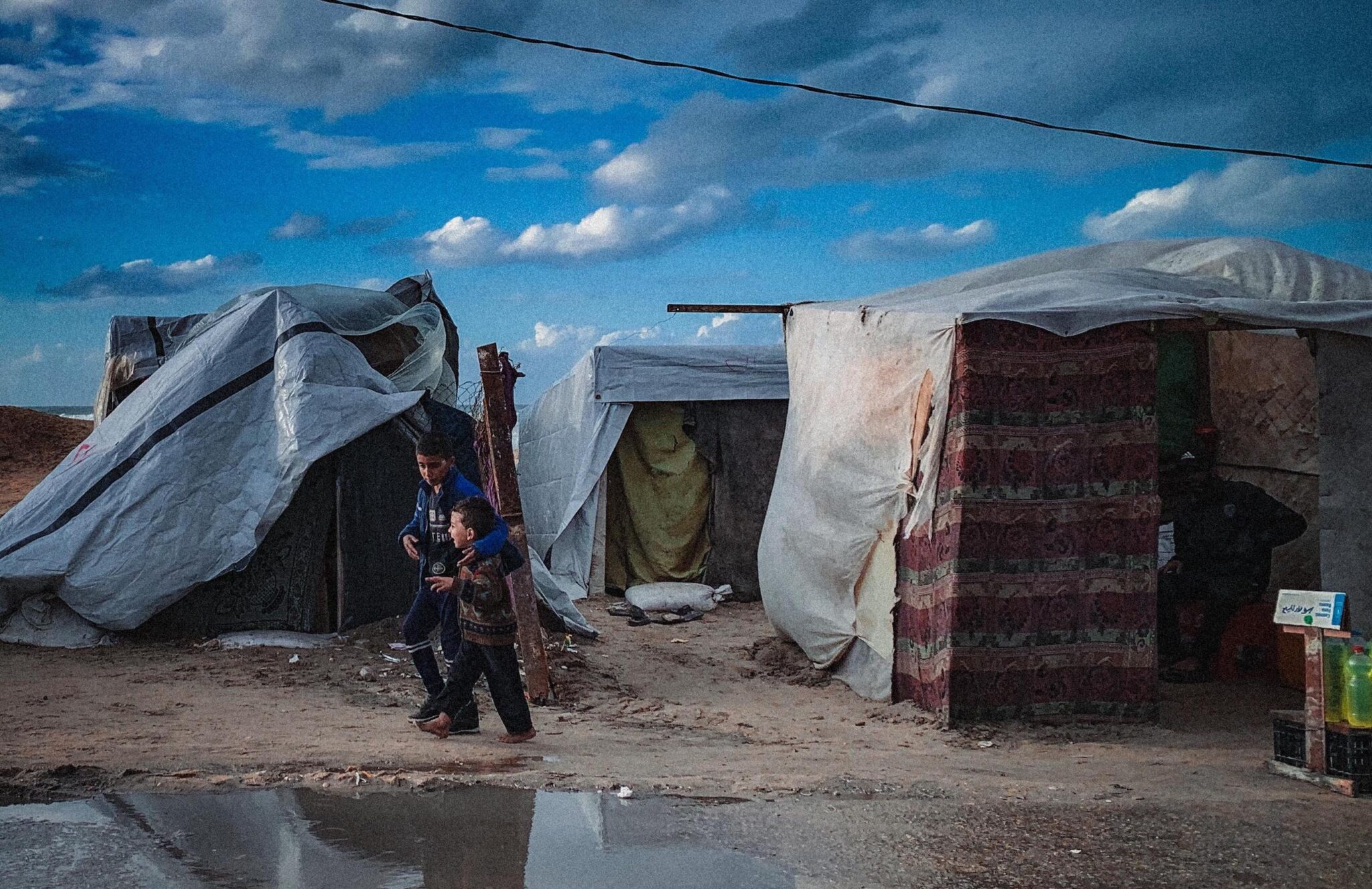
With the sounds of war starting to fall silent in the Gaza Strip after 470 days of brutal Israeli military assault and siege, a tiny crack of hope has opened for the Palestinian residents of the enclave that they will be able to gather the shattered pieces of their lives and begin the daunting task of rebuilding. But whether the deal reached by Israel and Hamas on Jan. 15 will lead to a decisive end to the war remains entirely unclear.
From a humanitarian perspective, almost anything would be an improvement compared to the kinetic horror, mass displacement, and orchestrated deprivation and starvation of the past 15 months.
Any sense of relief, however, is tempered by the sheer scale of death and destruction, the profound uncertainties of the ceasefire agreement, and the fact that the underlying issues that have fuelled human suffering in Gaza–and throughout the Palestinian territories–since long before this war began, remain unaddressed: Israel’s ongoing, illegal occupation; its administrative control of virtually every facet of life; and its deliberate thwarting of Palestinian autonomy and self-determination.
Uncertainties of the deal
The looming challenge of scaling up the humanitarian response amid widespread destruction, terms of access dictated by Israel, and the desperation of the population in Gaza—much of which has been on the verge of starvation for months–is just one of the questions left unanswered, or only partially answered, by the ceasefire agreement between Israel and Hamas.
The three-phase deal is essentially the same one that has been on the table since last May, and which was repeatedly scuppered by Israeli Prime Minister Benjamin Netanyahu and his far-right allies.
The first 42-day phase, which began on Jan. 19, involves an initial exchange of hostages held by Hamas for Palestinian prisoners and detainees held by Israel. The Israeli military will also withdraw from population centers in Gaza, the amount of aid allowed to enter the enclave is supposed to be ramped up to 600 truckloads per day, and displaced Palestinians will be allowed to return to their homes—or what is left of them.
The much more contentious issues of how Gaza will be governed and the conditions for Israel’s total withdrawal have been left for negotiations over the second phase of the deal, which aren’t set to begin until 16 days into the first phase.
Even if the first phase goes smoothly, there’s good reason to be concerned that the agreement may fall apart over the details of the second phase.
Netanyahu has vowed not to fully withdraw from Gaza until Hamas’ military capabilities are totally dismantled and the group is no longer in control of the enclave. Far-right Israeli Finance Minister Bezalel Smotrich threatened to quit Netanyahu’s governing coalition, potentially collapsing it, unless Israel continues the war after the first phase of the deal, controls the distribution of humanitarian aid, and gradually takes over the entirety of Gaza—conditions Netanyahu reportedly accepted.
Netanayahu has also said he received guarantees from the US that it will support Israel restarting the war if the deal falls apart, and other Israeli ministers have made cryptic statements about much remaining “hidden from view.”
If the second round of negotiations begin in good faith—doubtful, given the statements of senior Israeli politicians—it’s difficult to see how negotiators will be able to find common ground on the central question of who will govern Gaza after the war or even come up with a practicable plan.
The US, European countries, and Gulf Arab states have been pushing for a reformed Palestinian Authority, which governs the West Bank, to also administer Gaza. Israel has rejected that idea without outlining an alternative. Moreover, the Palestinian Authority lacks legitimacy among many Palestinians, who see it as a sub-contractor of the Israeli occupation.
Tellingly, the main arbiters of the conversation are Israel, which stands accused of committing genocide and numerous war crimes in Gaza over the past 15 months, and the US, which has bankrolled, armed, and provided diplomatic cover for the Israeli campaign. Consideration of Palestinians’ right to self-determination, or even to have some say in how they are governed, is completely absent.
A bleak picture
Realistically, what we could be looking at is a temporary ceasefire that lasts for part or all of the first 42-day phase, followed by Israel resuming its military campaign in some form or the negotiations falling apart over the question of post-war governance, leaving it unresolved.
In that case, Gaza would find itself frozen in limbo–neither at war nor at peace, with Israel reserving the right to carry out strikes on remnants of Hamas whenever they regroup. In the power vacuum, the territory would further fracture into cantons controlled by local powerbrokers, with pockets of anarchy in between—a process that is already underway.
UN agencies and NGOs would be left to try to keep the population on life support, subject to the amount of aid Israel decides to allow in, without ever really being able to stabilize the population or start the massive reconstruction effort that will be required to turn Gaza into a place that can support life once again.
Even if, defying the odds, Israel and Hamas are able to reach an agreement on post-war governance and phase two and three of the deal go ahead, culminating in the release of all of the remaining Israeli hostages—including the bodies of the deceased—and the beginning of a reconstruction plan for Gaza, the fundamental issues driving the conflict will remain.
Israel has made it clear time and again—including in a Knesset vote last July—that it is opposed to the formation of a Palestinian state, and much of Netanyahu’s political career has been dedicated to thwarting the creation of one.
Additionally, hints have already started to emerge about how the incoming Trump administration may have gotten Netanyahu to move forward with a ceasefire agreement that he had resisted signing for eight months under the Biden administration, including by lifting US sanctions on violent Israeli settlers in the West Bank, retaliating against the ICC for issuing war crimes arrest warrants for Netanyahu and former defence minister Yoav Gallant, and leading efforts at the UN to replace UNRWA.
Under a Trump administration that promises to be even more staunchly pro-Israel than the Biden administration, it’s difficult to imagine Palestinians seeing anything resembling their aspirations for a state being met, or justice and accountability for the crimes that have been committed during the past 15 months—to say nothing of decades of occupation.
So what are we to expect as this ceasefire takes hold?
The deal itself may only lead to a brief respite before the war resumes, or to the beginning of a new phase that may be less overtly violent but just as detrimental to life in Gaza in a slower and equally pernicious way. Sadly, a pathway to sustainable peace that would allow people in Gaza to recover, rebuild, and heal looks as far off as it has possibly ever been.
If there are points of light, they come from the mass protest movements calling for Palestinian freedom galvanised by this war, the activist-led efforts to isolate Israel diplomatically and financially, the fact that much of the world outside of the US and Europe clearly sees what is taking place, and the prospect of international legal mechanisms resisting the efforts to undermine them and trying to deliver at least a degree of justice and accountability.
— Eric Reidy for The New Humanitarian, Jan. 20 (condensed)
Photo: Rita Baroud/TNH





Trump calls for ethnic cleansing of Gaza
President Donald Trump said Jan. 28 he wants Egypt and Jordan to take in Palestinian refugees from Gaza while floating a plan to “just clean out” the Strip.
Speaking with reporters aboard Air Force One, Trump mentioned a call he had earlier that day with King Abdullah II of Jordan. “I’d like him to take people. I’d like Egypt to take people,” Trump said, adding that he plans to speak to Egyptian President Abdel Fattah al-Sisi on the idea. “You’re talking about a million and a half people, and we just clean out that whole thing. You know, over the century, it’s had many, many conflicts. And I don’t know, something has to happen.” (USA Today)
This of course echoes the genocidal rhetoric from Israeli officials, who face formal accusations of genocide before the International Court of Justice.
Israeli ban on UNRWA goes into effect
UNRWA is banned as of Jan. 30 under legislative deadline set by Israel, and must cease operation on Israeli land and within East Jerusalem. (PRI)
Trump: US will take over Gaza
Donald Trump made the shocking announcement Feb. 4 during a joint press conference with visiting Prime Minister Benjamin Netanyahu that he will pursue a plan where the US assumes ownership of Gaza, shortly after calling for the permanent displacement of the Strip’s residents.
“The US will take over the Gaza Strip and we’ll do a good job with it too. We’ll own it and be responsible for dismantling all the dangerous unexploded bombs and other weapons on the site, level the site and get rid of the destroyed buildings, level it out and create economic development that will supply unlimited numbers of jobs and housing for the people of the area,” he said.
When asked if this meant that Trump would send U.S. troops to Gaza, he said “if it’s necessary, we’ll do that. We’re gonna take over that piece and develop it, create thousands and thousands of jobs. It will be something the entire Middle East can be very proud of.”
Amnesty International welcomes release of Palestinian prisoner of conscience
Amnesty International on Feb. 7 welcomed Israel’s release of Palestinian humanitarian aid worker and prisoner of conscience Mohammad al-Halabi.
Amnesty referred to Mohammad al-Halabi’s imprisonment as a “flagrant miscarriage of justice,” and and demanded the release of all hostages held in Gaza as well as all Palestinians “arbitrarily” held in Israel’s prisons.
Amnesty senior director Erika Guevara Rosas said that Israeli authorities targeted Mohammad al-Halabi precisely because of his humanitarian work, unjustly detained him, deprived him of all due process rights, and wrongfully convicted him. Guevara Rosas added that Mohammed al-Halabi spent nine years in detention due to multiple trial postponements, and showed signs that he was starved and tortured by Israeli officials. She also mentioned that the trial primarily relied on a prisoner informant’s statement, and that his wrongful conviction must be quashed and independently investigated, and that all officials involved must be brought to justice.
Mohammad al-Halabi’s release was part of a deal between Israel and Hamas following the ceasefire that took effect on Jan. 19. To date, the International Red Cross reports that 583 Palestinian detainees have been released from Israel’s detention centers while many more families still await the release and return of loved ones.
Israel officials arrested Mohammad al-Halabi in 2016 based on allegations that he embezzled $50 million in material support to Hamas. Israel’s Beersheba District Court then convicted and sentenced him to 12 years in prison. Throughout his nine years of imprisonment, he asserted that he had been denied a fair trial, and maintained innocence. He was released on Feb. 1. Human rights groups including Amnesty as well as the UN have cited multiple concerns over the years regarding Mohammad al-Halabi’s denial of due process rights and treatment in detention centers. (Jurist)
See our last report on the fate of the hostages.
Gaza hostage release goes down to the wire
The Hamas-Israel ceasefire nearly collapsed over the course of this week, but a return to all-out war in Gaza may have been averted, at least for now. Hamas said on Feb. 11 that it was postponing the release of three hostages—planned for Feb. 15 in exchange for Palestinian prisoners in Israel—because of what it said were Israeli violations of the deal, including preventing civilians from returning to north Gaza and blocking aid. Trump then warned that “all hell is going to break out” if Hamas did not release “all” hostages, muddying the waters about how many hostages Israeli Prime Minister Benjamin Netanyahu’s government expected to see freed by the midday Feb. 15 deadline (76 remain in Gaza, although it is not clear how many are alive). A flurry of diplomatic activity followed, with Egyptian and Qatari mediators leading talks in Cairo that reportedly focused on Israel allowing caravans, tents, fuel, medical supplies, and heavy machinery into Gaza. By Feb. 14, Hamas said it was committed to the truce and planned to release the hostages (now named) as scheduled following the “removal of obstacles.” (TNH)
UN secretary-general calls for commitment to Gaza ceasefire
UN Secretary-General António Guterres’ office issued a statement on Feb. 16 welcoming the ongoing fulfillment of the ceasefire deal in Gaza, urging both parties to remain committed to its terms and emphasizing the importance of adhering to international humanitarian and human rights law. The statement came a day after the release of three Israeli hostages from Gaza in exchange for 369 Palestinian prisoners held in Israel.
The exchange marked part of the agreement’s first phase, which came into force on Jan. 19 and is expected to conclude by March 1, after which negotiations are to commence for a permanent ceasefire. The three-phase deal includes a gradual de-escalation of hostilities, with phase one facilitating the withdrawal of Israeli forces from populated areas in Gaza, the return of displaced Palestinians to their neighborhoods, and a substantial increase in humanitarian aid deliveries, according to UN News.
The initial has made good progress despite a roadblock when Hamas threatened to postpone the release, claiming Israel had broken the ceasefire terms; an accusation Israel rejected. The situation was ultimately resolved through the intervention of Arab mediators.
The Secretary-General’s statement noted that the “UN remains fully engaged in supporting the implementation of the deal, including through the delivery of critical humanitarian aid to Palestinians in Gaza.”
Since the ceasefire took effect, the United Nations Relief and Works Agency for Palestine Refugees in the Near East (UNRWA) has provided shelter supplies to 644,000 people, distributing essential items like tents, blankets, winter clothing, tarpaulins, and materials to seal structures. Moreover, the agency has also expanded its food distribution, successfully delivering food parcels to 1.5 million people. (Jurist)
Netanyahu orders immediate enforcement of law banning UNRWA
Israeli Prime Minister Benjamin Netanyahu instructed authorities to begin the immediate enforcement of the law banning UNRWA on Feb. 18. The UNRWA law was passed by the Knesset with broad support, and prohibits the United Nations Relief and Works Agency for Palestine Refugees (UNRWA) from operating in Israel and bars Israeli authorities from any contact with the agency. (Jurist)
Gaza children dying due to cold weather and lack of shelter
Medics and health officials say that at least six infants have died in Gaza over the past two weeks, due to cold weather and a lack of proper housing and heating. Over the course of this winter, Gaza’s health department has recorded 15 deaths from hypothermia, all children. With the majority of Gaza’s more than 2 million people displaced at least once by Israel’s heavy bombardment and ground campaign that have killed more than 48,000 Palestinians, many people are staying in tents or other makeshift shelters that easily flood. While more than 586,000 people have returned to northern Gaza since a late January ceasefire, they haven’t been able to go home in the traditional sense: They have found bombed-out buildings and utter destruction. People say that despite the increase in aid since the ceasefire, it is still not enough. (TNH)